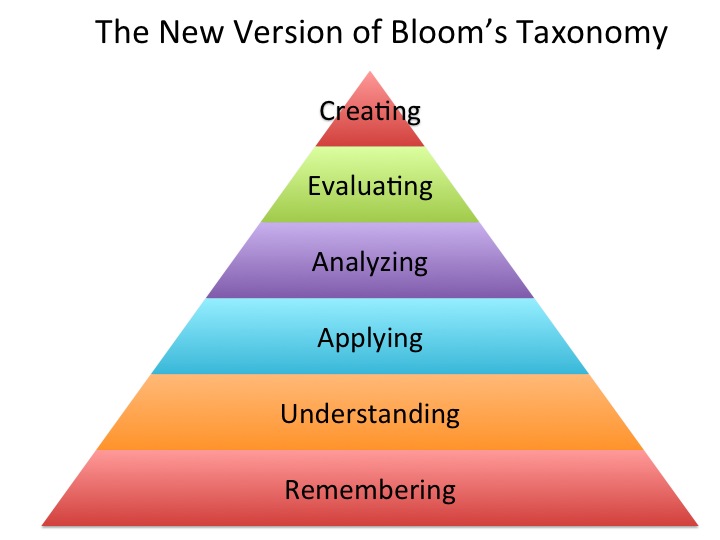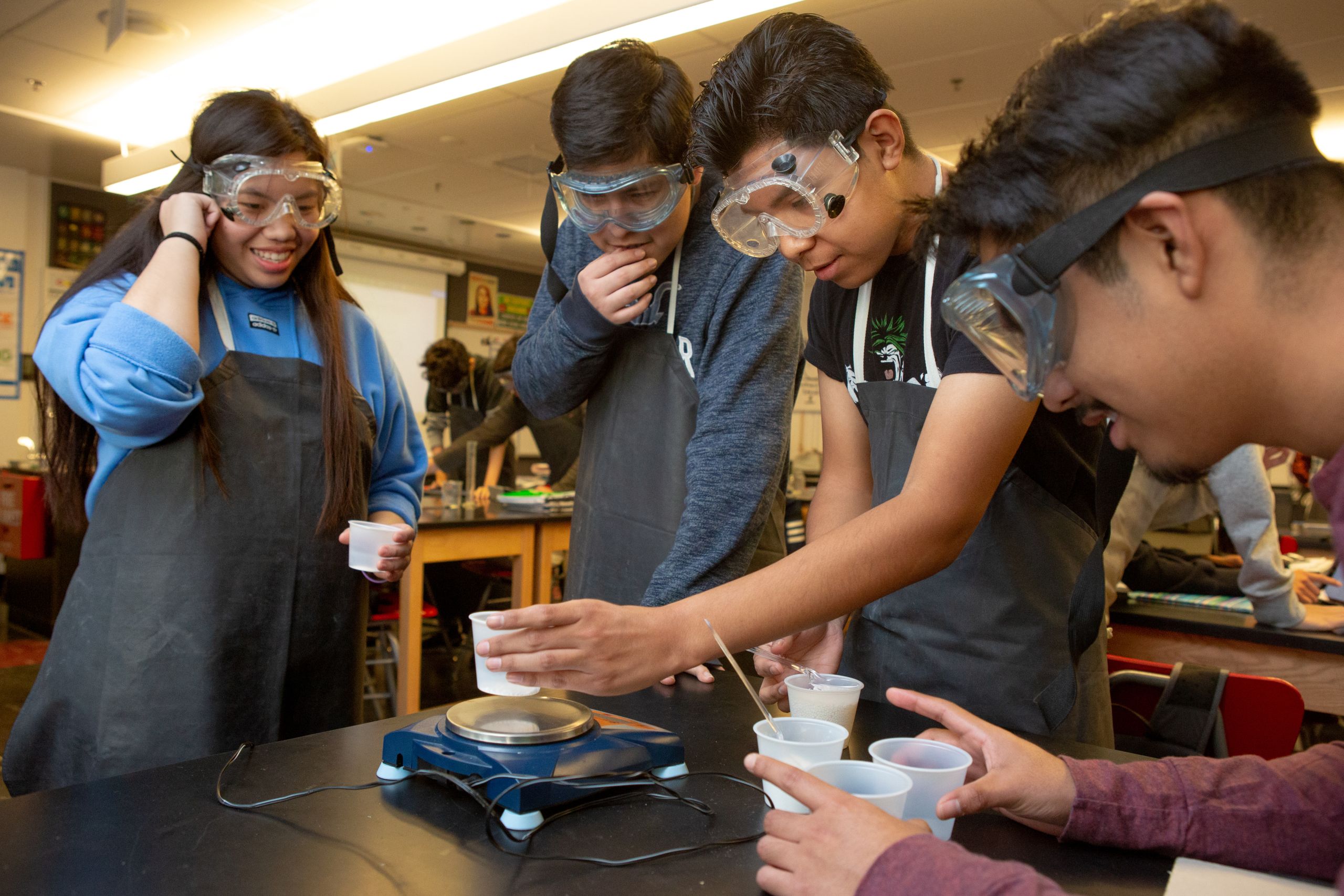Divergent thinking and convergent thinking are the two harmonious thinking processes that lie at the heart of all creative productivity. In our first blog, Divergent Thinking: Pumping up Student’s Creative Muscles, we highlighted the need for increasing students’ divergent thinking opportunities and skill sets. In this blog, we share strategies for honing students’ convergent thinking skill sets and explore the relationship of both in creating.
Creating is now recognized as the highest form of rigorous thinking you can incite in your students. The revised Bloom’s Taxonomy places it above all other forms of cognition in the learning process.

Harmonious Thinking
Opposites do attract – even inside our brains! Hold on to that thought as you consider the two types of thinking humans can do. One is the production of ideas, creative/divergent thinking, accomplished by generating many possibilities and widening your focus. The other is the evaluation of ideas, critical/convergent thinking, accomplished by narrowing your focus and sorting the generated ideas to identify the interesting/useful and unique ones.
John Spencer’s Convergent Thinking Versus Creative Thinking video shares how “convergent thinking is linear and systematic while divergent thinking is web-like or hacker-like, focusing on the connections between ideas.” He simplifies the polarity of the thinking by asking us to view them as The Why? vs. The Why Not! The title of the video is somewhat misleading, as both types of thinking are intimately involved in the creative process. Much more of a symbiotic relationship! Both are required to produce the best creative outcomes. Take a look at our creativity formula to help you get your head around it!
Creativity = Creative Thinking + Critical Thinking + Creative Productivity
The second video we selected is The “Think Wave” of Critical and Creative Thinking. It explains the nuances of the creative process using a wave pattern. Brilliant! Body motions can help students grasp the meanings of creative and critical thinking. Wide-open arms (creative) and a tight hug (critical) are examples. Challenge your students to come up with their own and select a class version to use periodically throughout instruction. You can also reinforce students’ understanding by reading a list of questions and having students or teams make the body motions indicating the type of thinking needed to answer each one. Help your students “ride the wave” to internalize these beliefs:
Critical thinking (convergent thinking) without creative thinking (divergent thinking) is insufficient. Critical thinking in isolation leads to narrower and narrower thought processes (inside the box). Too much critical thinking can cripple creative thinking.
Creative thinking (divergent) without critical thinking (convergent) is also insufficient. Creative thinking in isolation leads to wider and wider thought processes (outside the box). Creative thinking can inform critical thinking and open new pathways to thinking or action.
Business and Classroom Needs
“Critical thinking is the key to creative problem solving in business.”
~ Richard Branson
According to an American Management Association Survey, 72% of employers believe critical thinking is key to organizational success, but only half of those surveyed said their employees actually show this skill. When hiring, managers want critical thinkers, but what do they really mean?
Critical Thinkers:
- Read between the lines. Think critically by using logical arguments and challenging evidence to sift through the noise.
- Dig deeper. Think about your thinking, while you’re thinking, to be able to improve your thinking.
- Are skeptical. Critical thinkers know not to jump on the first good idea they find. They consider all possible alternatives and explain their work or ideas.
- Come prepared. Fewer than half of employers surveyed believed students were equipped with solid problem-solving skills.
- Incorporate conflicting data. Challenge assumptions and consider other sides by researching all sides of the idea and information before making a decision.
The problem that often exists (in the classroom) is the somewhat superficial use of the terms creative and critical. To help students acquire a more thorough understanding of these cognitive pathways, we challenged them to dissect Don Treffinger’s (Creative Problem Solving) complex definitions of creative thinking and critical thinking. And to create their own! Moving from the complex to the simple is a deep thinking (convergent) process that involves analyzing and evaluation. And as we know, “in your own words” makes for a more meaningful and personalized creative (divergent) understanding. Enjoy the student-created examples below from Patti’s Lakenheath Middle School (United Kingdom) Creative Thinking classroom.
“Creative thinking is like bumping into blanks and using your mind loosely to come up with purposeful new relations to create crazy, wild, not typical ideas.”
~ Gabriella, 7th grade student
“Critical thinking is looking at options and inspecting choices equally, evenly, and gently, with full attention, and then paying attention to your thoughts to perfect and improve promising choices.”
~ Cavan, 8th grade student
Tools to Improve Convergent (Critical) Thinking
Both 21st century teachers and businesses recognize critical thinking as one of the most important educational goals. Yet it can be challenging to embed opportunities to practice critical thinking skill sets in everyday teaching. Recognizing that students are presented with numerous decision-making opportunities throughout the day is the place to begin.
Critical thinking tools are versatile tools! They can be used to teach students the power of thinking deeply about any decision, idea or choice. Or the best way forward in any problem-solving situation. It should be noted, the primary intent of these tools is not to change students’ minds; rather, they are designed to unemotionally and without bias explore ideas in-depth. The exploration may result in a change of position on an idea or viewpoint or perspective.
Critical Thinking Tools
How many times have you, when faced with the task of making a decision, made a mental list of the pros and cons and eventually pulled out a piece of paper to list them to help you decide? This is helpful but somewhat limiting. Enter two simple critical thinking tools: the PMQ (Pluses, Minuses, & Questions) and the Choice Board. Both simple and effective! We designed these to assist students in understanding the power of thinking more strategically about a decision, idea, choice, or plan of action.
PMQ
The PMQ is a deliberate and disciplined tool yielding better results. Leading to a more objective decision. It allows students to explore any idea/choice or possible decision without the hindrance of emotional interferences that cloud their thinking and judgment. It also leads, quite naturally, to the very important next steps or “what if” questions or situations that should be considered before the final decision or problem-solving process is put in place. Here are two mini-poster resources to remind your students to use Kreative Kwestion stems and to avoid Kreativity Killer statements when engaged in creative and critical thinking!
Take a look at the Teachers Move PMQ. It was created by middle school students to further contemplate a suggestion they generated using SCAMPER to make their school the “best school in the world.”
Student Suggestion: Middle School teachers move from class to class and students stay in the same room all day long.
Need a hint: You might do the same PMQ several times over a period of time to continue to collect ideas/suggestions.
Choice Boards
The Choice Board is a versatile tool that helps students create and then prioritize a number of variables involved in making a decision/choice. We all recognize that decisions made hastily and emotionally often do not produce the best outcomes. The Choice Board moves students towards making more logical and thoughtful decisions while allowing for personal preferences. It can be used to make a variety of decisions or choices: choosing a sport, musical instrument, or a college. The possibilities are limitless. Take a look at the student sample Choice Board: Choosing a Pet.
Need a hint: After completing any Choice Board, if the choice does not “feel” right, go back and use different or more specific criteria.
Help your students believe in their ability to think creatively and critically. Use the list below to encourage them to examine their attitudes towards thinking. Modeling your attitudes through your behaviors and verbalizing your thinking processes will help convey the following:
- Tools improve thinking.
- Thinking requires effort.
- Thinking takes time.
- I can get better at thinking.
- Sometimes I need to re-think.
- I enjoy thinking.
- I am a thinker.
- Thinking is fun!
Moving On!
In a team or school-wide setting, create a list of words or phrases (1-3 words) for each letter alphabet for creative thinking and critical thinking. This can be an on-going task that is added to throughout the school year. Encourage creativity! And wow! What a fun activity to do with your students or colleagues! We’re sure you and your students will find these tools add a dash of fun and a ton of rigor to critical thinking scenarios! In the meantime enjoy this Creative & Critical Acrostic designed by a team of Patti’s middle school students.
Interested in Learning More?
We have partnered with CIESC, Keep Indiana Learning, to offer Creativity-Based Learning courses. Each one is filled with curated resources, cultivated lesson designs, and authentic student work products. Course One: Introduction and Person (45 credits) and a FREE SAMPLE Module 4: Curiosity (4 credits) are available now. Visit https://curiositateaching.com to view additional publications and resources.
CBL Course One: Introduction and Person Teacher Exit Card from a Springville Academy Middle School Teacher
- I now know: “Creativity can be taught. Creativity leads to students being more engaged in their learning.”
- I now feel: “I feel like I have a new sense of purpose and direction. My content area is a vehicle for teaching creativity.”
- I will now do: “Stop doing group work and teach students cooperative collaboration!”
- Phrase representing the course: “The revolution starts in my classroom! Incorporate creativity everyday!”
Resources
Please login or register to claim PGPs.
Alternatively, you may use the PGP Request Form if you prefer to not register an account.



